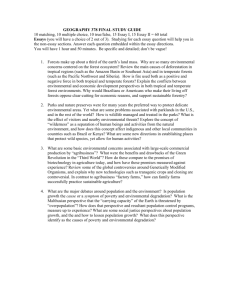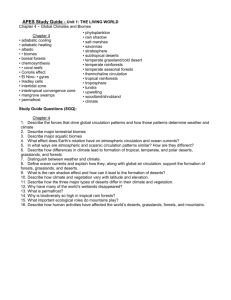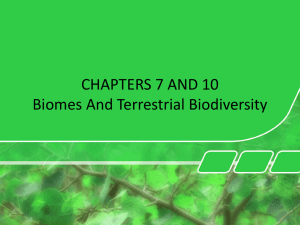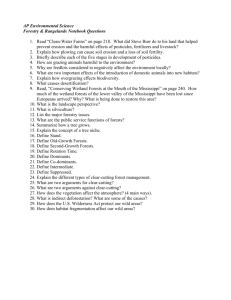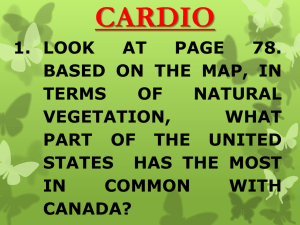occur on all continents except Antarctica. Major desert plants of each
advertisement
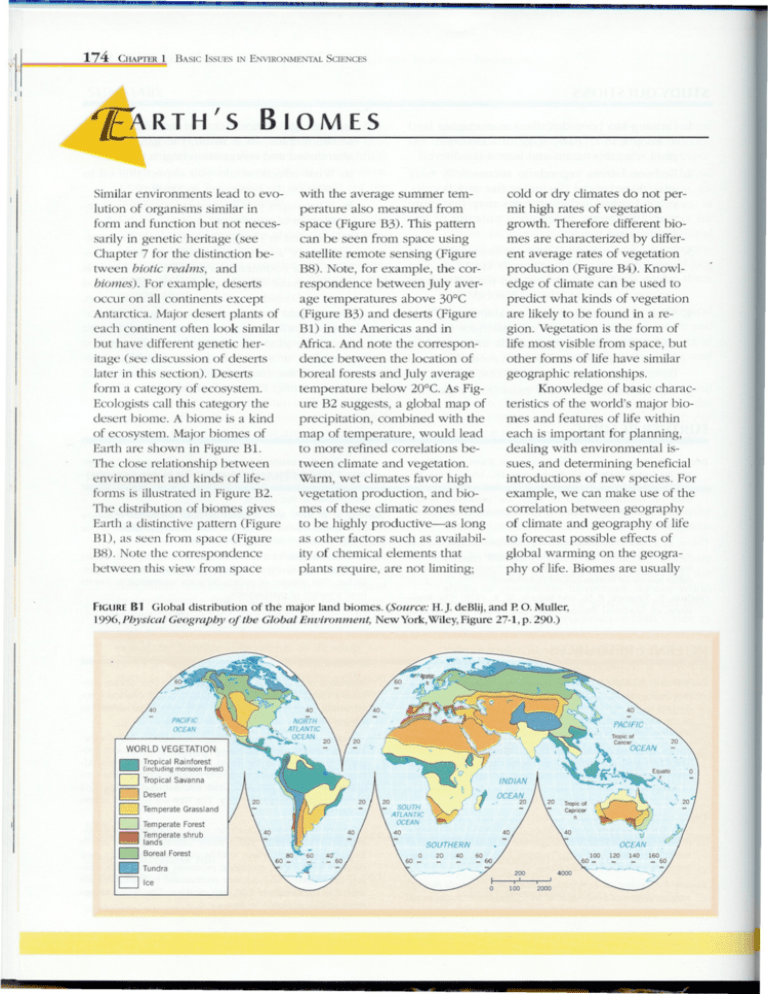
m h ra of v i a ch b d r tween biotic realm and Bl) in the Am and in tem bel 20° As Fig ure B2 sug a g ma of lo deser biom A b is a k iom ind m a fe o l w n i map of tem wo lea Earth are show in Figu Bl. su an de b C ex w c m u o t a mes of thes clim zon ten Bl), as seen from spac (Fig betwe this view from FIGU B 1G distr of the maj land bio (So lob H.] de an P. O. M 1996, Phys Geog of Glob Env New Yo Wi Fig 27 29 -B Fore ore \ BIOMES \ 1[~RTH/S \ Similar environments lead to evo- lution of organisms similar in form and function but not neces- sarily in genetic heritage (see Chapter 7 for the distinction bebiomes). For example, deserts occur on all continents except Antarctica. Major desert plants of each continent often look similar but have different genetic heritage (see discussion of deserts later in this section). Deserts form a category with the average summer cold or dry climates do not per- tem- perature also measured from space (Figure B3). This pattern can be seen from space using satellite remote sensing (Figure B8). Note, for example, the correspondence between July average temperatures above 30°C (Figure B3) and deserts (Figure Africa. And note the correspondence between the location of boreal forests precipitation, of ecosystem. Major biomes close relationship environment forms between and kinds is illustrated of life- in Figure B2. The distribution of biomes gives Earth a distinctive pattern (Figure Note III the !;;;;d Desert !!!!!!!!!!!!I lands mz::J correspondence Tropical Rainforest (includingmonsoonforestlDTropicalSavanna B8). Tundra with tween climate Warm, wet vegetation correlations and climates different bio- ent average rates of vegetation production (Figure B4). Knowledge of climate can be used to predict what kinds of vegetation are likely to be found in a region. Vegetation is the form of life most visible from space, but other forms of life have similar each refined Therefore the of to more The combined growth. geographic relationships. Knowledge of basic characteristics of the world's major bio- and July average of ecosystem. Ecologists call this category the DTemperateGrasslandDTemperateForest~Temperateshrub II Dice il1 CHAJ>JER1BASICISSUESINENVIRONMENTALSCIENCES 114 be- is important dealing with for planning, environmental is- vegetation. favor production, high introductions of new species. For and bio- correlation to be highly productive-as long as other factors such as availabil- ity of chemical elements that plants require, are not limiting; between geography of climate and geography of life to forecast possible effects of global warming on the geography of life. Biomes are usually " EB 1 FIGU 82 Simp diag of the rela betw pre and lat an Ea m l b H l a H.]. deBli and P. O. Mull 1996 Phy Geo of the Glo En W N Y F 2 p 2 i e name for the dom vege Arc tund typ hav im port larg ma as we ga in so ar is a l i versu warm deser sma rod and ins Al low rainfa and low aver temperatu (Figu BS). (Fig B1 and B3 sugg that arcti tund perm are ma be per sm tre ty u 3 m There are two kind of tunvery long tim to rec As the ~ !Ii ~ II< tude serves as an index of average temperature, tion (e.g., coniferous forests as opposed to grasslands), for the dominant the shape and physiognomy) nant form of the organisms (forest (called so "latitude" can be replaced by "average temperature" latitudes, and alpine, which occurs at high elevations. The vegetation of both is similar, but the dominant animals are different. harsh, the vegetation grades from dwarf shrubs and grasslike as tica, where the major land or- domi- versus shrub land), or for the dominant climatic conditions (cold desert important small mammals, birds, and insects; in alpine tundras, the dominant animals are plants to mosses and lichens, and finally to bare rock surfaces with occasional lichens. The extreme tundra occurs in Antarc- that grows below Tundra Tundras are treeless plains that occur under the harsh climates of tundras occupy comparatively small, isolated areas, whereas arctic tundras cover the large territories required for populations of large mammals. Parts of tundra have per- in the where ture northern hemisphere the July is 15°C average or lower.) occurs tempera- The domi- nant vegetation includes grasses and their relatives (sedges), mosses, lichens, flowering dwarf shrubs, and mat-forming plants. mafrost, which is permanently frozen ground. Such areas are extremely fragile ecologically; when disturbed by such activities as the development of roads, nently changed Taiga, dra: arctic, which - --- -- occurs at high environment within the rocks, just surface. or Boreal Forests The taiga biome includes the forests of the cold climates of high latitudes and high altitudes. Taiga forests are dominated by conifers, especially spruces, firs, and larches, and certain kinds of pines. Aspens and birches are important flowering trees (Figure B6). Boreal forests are characterized by dense stands of relatively or may take a which -- in this diagram. (Source: becomes more make form walking dense shade difficult. and Although EAR BIOM FIGU 83 Mean sea-l air temp (OC for July (So H.] de an P. 0 M 1966 Phys Geog of the Glo Env Wi Ne Yo Fig 893 areas relati few impo amo the mo eco FIGU 84 Geog of vege prod The diff bio are ch by and temp decid fore are high pro Thi is ano wa tha we ca se the relati betw clim and biom (So H.] deB and P. O. M 19 Ph D Lessl boreal forests cover very large species of trees occur. There are only about 20 major tree species in North American boreal forests, different cal average Geography rates of the of the production Global Environment, for example. Boreal forests ern areas are important biomes as they are the source of much lumber and paper pulp. of vegetation. Because Tropical Wiley,NewYork,Figure the north- forests, temperate 26-3,p. of North America and Eurasia have been connected by land bridges during past ice ages, the animals and vegetation of this biome have been able to rain forests, 281.) ", PACIFIC 0' I...""y;~ [I OCEAN1500-2000gramsperm'Cd500-1499gramsperm'D110-499gramsperm' Ji!j JULY-"'~-~-.--,_."",-'"u".~-,..---u-----u-~~-~~--~---"--""'- 176 ,.,I E B 1 fow and car lan bir vo in de T l d o such as owl and eag sit of la m re i iary D turb c e s par s cuI ad y gr to ar sm m in Wa Can Are of so or an sm p dec tree com spe an w ce T a tal th 70 m a l o n FIGU 85 Tund biom Arct tunsprea wide Moo for exam mam (moo deer wolv and bears smal rode (squ rels rabbi carn FIG 86 The bor for and am acm othboh , common ~-~~~~~~G'* fires, storms, insects-are "" : ~p~ ~ "'." *,>, f ,, , , '\~" ,, "" and outbreaks of common in the bo- part taiga; herbi- from the deep shade of the forest interior; there is less for 0 real forests. For example, the entire million acres of the Bound- feed Minnesota those burns over (through somewhat important hardwood warmer than economically for their trees used for furni- ture. Temperate deciduous forests are among the biomes most changed by human beings because they occur in regions long dominated by civilization. In the temperate deciduous forest, large mammals are less Eurasia share both genetic heritage and similar shapes and The dominant forests include animals of a few large vores (foxes), many insects, and migratory birds, especially water- animals that live in trees (such as Temperate Forests forests occur in cli- are maples, beeches, oaks, hickories, and chestnuts, typically larger in stature than trees of the boreal forest. These forests are ple, are found in both continents. In this case, the boreal forests of North America and dominant Temperate mates National Park, Alaska, avens in bloom. The squirrels) and those that feed on those of the boreal forest. These forests occur throughout North America, Eurasia, and Japan and have many genera in common. Dominant vegetation includes tall dra in Denali with mountain on. numerous small fires) an average of once each century, and individual forest stands are rarely more than 90 years old. Temperate boreal in the . form. ,'"~" ", "~ftt , than $ (such as mice). Birds and insects are abundant. Rain Forests Temperate rain forests occur under moderate temperature regimes where the rainfall exceeds 250 em/year. Such rain forests are rare but spectacular; these are the giant forests (Figure B7). In the Northern Hemisphere, the dominant trees are evergreen conifers. This biome includes the redwood forests of California and Oregon, where the tallest trees in the world exist. It also includes forests of the state of Washington and adjacent Canada, dominated by such large trees as Douglas-firs lived; Douglas-firs live more than 400 years. Temperate rain forests also occur in the Southern Hemi- EAR BIOM are the fore of we Ne of us fo re S Am oc fr N E co di to w pe sh la o A d low ra th is co FIGU 87 Temp rain fore biome Moss cove Sitka spru in dom by sm tree suc as FIGU 88 NAS Land imag of the veg of Ear fro spa (Fr "T En E am sF to the lOath anniv issue Nati Geo Ma 198 Th sam m cbe ob fr G H a 178 sphere, the best known of which Zealand. Temperate rain forests comparatively low diversity have of plants and animals, in part because the climatic conditions tend to favor specialized species, in part because the abundant growth of the dominant vegeta- oaks. The stands tend to be open, allowing considerable light to reach the ground. These generally pleasant areas are pines are typical of many perate woodlands tem- and, in North land south to Georgia and the Caribbean islands. Fires are a tion produces a very deep shade in which few other plants can grow to provide food for herbivores. This biome economically; is important redwoods, glas-firs, and western major crops. North Temperate American Olympic National Park, a famous exam- timber Woodlands Goddard Space Flight Center, Code forests, but the climate is slightly drier. Temperate woodlands are pinyon 623, Greenbelt, pines MD.) species are Temperate Under adapted. Shrub still drier Lands climates tem- Dou- cedars are Temperate woodlands occur where the temperature patterns are like those of deciduous ple of the temperate rain forest of the Pacific Northwest of North America. many and evergreen tinctive feature of this biome is the chaparral, a miniature woodland dominated by dense stands of shrubs that rarely exceed a few meters in height. Chaparrals occur in Mediter- ranean climates, in the cool season. climates with Chaparrals are found along the coast of California, in Chile, in South Africa, and in the Mediterranean E B 1 mamm reptil and smal are chara the scent of sage; some scien tists believ the arom com FIG 89 Tem gra bio Th Gr A P w o dead twigs and branc As a result stand are rarel more rates can incre to some of the teb ar ab an s to be ve lo in nu M mes occ In the we clitoo moist for deser A m ajo rai w ra re ma ch el n south Afric and the pam flowe plant many of whic of tree with a f squ kil ew kind of plan som like pal low ra tr sa BIO Man spe of ani tree but som are gro region. There are few large Typically, the vegetation is distinctively aromatic, such as pounds are a means of competition among the plants. Its animals and plants have little economic value at present, but this biome is important for wa- tersheds and erosion control. Be- cause they occur in climates desirable for settlement, chaparrals are undergoing rapid change by human activities. The vegetation is adapted to fires; many species regenerate rapidly, and some promote abundant fires by producing fuel in the form of than 50 years old. When intense precipitation follows fire, erosion highest known, until renewed vegetation again protects the slopes. Managing fires in chaparral is especially important because housing is often near the fire-prone vegetation. of the world's largest areas of temperate ment of North America. American West; the kangaroos of Australia; and the antelope and other large herbivores of Africa. Temperatures Temperate grasslands occur in regions too dry for forests and biome in terms of area covered, these grasslands include tl1e great North American prairies (Figure B9), the steppes of Eurasia, the plains of eastern and of South America. Dominant species are grasses and other are perennials Rain Forests Where the average temperature is high and relatively constant throughout the year, tropical biomates and in climates with rain- dwellers. Insects and other settle- inver- a high diversity. Rain forests occur in some of the most remote regions main poorly of Earth known; and re- many undiscovered species are believed to exist there. Except for dead organic matter at the surface, soils tend chemical elements (nutrients) are held in the living vegetation, which has evolved to survive in this environment; otherwise, the year are found the tropical rain forests of South and Central America, northeastern Australia, Indonesia, the Philippines, Borneo, Hawaii, and parts of Malaysia. Species diversity is high, with hundreds of species with extensively developed roots. Soils often have a deep organic layer. The highest abundance and the greatest diversity of large mammals are found in grasslands: the wild horses, asses, and antelope of Eurasia; the once-huge herds of bison that roamed the prairies of the I sim- fallwelldistributedthroughout Grasslands moderate, ilar to those of the temperate deciduous forests, and rainfall is usually seasonal. Tropical Temperate are grasslands, prior to European meters. Typically, some trees are very tall, but there are many trees ers, ferns, occur; remain like relatively bromeliads grow on mammals small; and trees tend for Tropical Forests life. Seasonal and Savannas Tropical seasonal forests occur where rainfall is high but very seasonal, in India and Southeast Asia, Africa, and South and Central America. In areas of even oth- some nas-grasslands (Figure to live sary in with scattered trees-are found. These include the savannas of Africa, which, along with the grasslands, have the greatest abundance of large EAR BIOM FIGU 810 Trop rain fores biom The veg alo the Seg Ri mamm rema anyw in the world The numb of plan beco very pro Di ban are com in the for Austr occu at low latitu FIG 811 Des bio De lan at W Sa N M New Mex var gre in the am of ve th c This dese is rela spa bu som ha no 180 illustrates lowland tropical rain forests. Asia. Most deseIts have a consid- species is high. Disturbances, including fires and the impact of herbivory on the vegetation, are common but may be necessary to maintain these areas as savannas; otherwise, they would revert to woodlands in wetter areas or to shrub lands in drier areas. Under still drier climates, savannas are replaced by shrub lands, characterized by small shrubs, a generally low abundance of vegetation, and a low density of vertebrate erable amount of specialized vegetation, as well as specialized vertebrate and invertebrate animals. Soils often have abundant nutrients but little or no organic matter and need only water to of occasional fires, occasional cold weather, and sudden, infrequent, and intense rains that cause flooding. There large dominant are relatively mammals animals in deserts. of few The warm deserts are nonmammalian veIte- brates (snakes and reptiles). '" : t.. ..;;:;:-"P -""~D~ in Borneo animals. Deserts Deserts occur where the rainfall is less than 50 em/year. Although most deserts, such as the Sahara of North Africa and the deserts of the southwestern United States (Figure Bll), Mexico, and cold deserts occur in the basin J and range area of Utah and Nevada and in parts of western ~I E B 1 Mam are usua smal like decay takes place slow and only FIG B 1 We bio We inc 2 ar of op st w 9.8(a) and (b).) Swam and rangi from smal trees such as ians few mam are exc larg swa of wa reg chang in eleva mak a small trees can grow in lowe sma upla are Earth land area, they are imbiosp Over geolo time breed areas for many ocea anima and conta man inve FIG B 1 Fre bio Th Gr 3 La of N A a Min Cas Pic Ro Na th sh trb the kangaroo mice American deserts. of North Wetlands Wetlands include freshwater swamps, marshes, bogs and saltwater marshes. All have standing water: the water table is at the surface, and the ground is saturated with water (Figure BIZ). Standing water creates a special soil environment with little oxygen, 111 ~i so plants with specialized roots can survive. Bogs-wetlands with a stream input but no surface water outlet-are characterized by float- ing mats of vegetation. marshes are wetlands (See Figure with III and areas of herbs, grasses, shrubs, and trees that can withstand frequent flooding. of warm or surface inlets and outlets. Dominant plants are small, mangroves persistent coastal wet- lands to black spruces and larches of the north, to shrubs, sedges, and mosses. Small great difference; on slight rises, roots can obtain oxygen and Dominant animals in fresh- Fresh water wetlands are many species of insects, birds, and amphibinhabitants of this biome. Although ponds, Waters freshwater rivers, and lakes, streams make up a very small portion of Earth's surface, they are critical for our water supply for homes, industry, and agriculture and play important ecological roles (Figure B13). They are major recreational resources but are The are famous for large reptiles and snakes, as well as for a relatively high diversity of mammals where topographic variation allows easily polluted. areas are patches of open water with algae and mosses. Although wetlands occupy a relatively small portion of Dominant plants portant in the biosphere. In the oxygenless soils, bacteria survive that cannot live in high-oxygen atmospheres. These pacteria carry out chemical reactions, such as the production of methane and hydrogen sulfide, that have important effects in the wetland environments produced the vegetation that today is coal. Saltwater marshes are important tebrates. Dominant animals in- clude crabs and shellfish, such as clams. therefore resource. SaltWater an marshes important are the world's most famous examples of the freshwater biome. In this economic the waters of the lake and the adjacent forests is clearly illustrated. picture, at . : EAR BIOM in shallo areas are roote flow Open water have many smal ope wat of mu of the In so ar de w a rusdes wit low River and strea are imfro sh T fe u mal occ but at low den abund of fish. They are importa as breed sites for man dark and life is sca Ho wh su gi cl who die in surf wa and The intert biom is mad up Flow Oce Eco Upw flow or "up of FIG 814 Inte bio Ro int bi on th A co and today some majo legal coni:I:II '.~~'" 182 are floating algae, referred to as phytoplankton, Along shores and ering plants, such as water lilies, Animal life is often abundant invertebrate animals (collectively called zooplankton)-both herbivores and carnivores. Many species of finfish and shellfish are found, flicts continue about access to intertidal areas and harvesting of biological resources. oceans. These productivity portant in the biosphere transporters of materials as major from vast areas be low in nitrogen and tend America, West Africa, and near the Arctic and Antartic ice sheets, to and phospho- low diversity nutrients Benthos ("deeps") is the bottom portion of oceans. Primary input of food is dead organic matter that falls from above; the waters are too dark for photosynthesis, so no plants grow there. Upwellings are among the ocean waters are cold, Hydrothermal This recently Vents discovered biome (see Chapter 4) occurs in deep ocean, where plate tectonic processes create vents of hot water with a high concentration of sulfur compounds. These sulfur compounds provide an energy basis for chemosynthetic bacteria, fish. these waters are nutrient rich because of numerous creatures Intertidal of areas exposed alternately to air during low tide and ocean waters during high tide (Figure B14). Constant movement of waters sink. (See North America. Chapter 8 worms, and other unusual usually abundant and form a major part of economic resources. Near-shore areas are often important breeding grounds for many species of fish and shellfish, often of economic significance. This near-shore part of the oceanic environment is most susceptible to pollution from land sources; as a major recreational area, it is subject to considerable alteration by people. Some of the oldest enviconcern the rights of this biome, life- forms. (See Chapter 8.) Water pressure is high, and temperatures range from boiling point in waters of vents to the frigid (about 4°C) waters of deep ocean. ~ transports nutrients into and out of these areas, which are usually rich in life and are major economic resources. Large algae are found here, from giant kelp of temperate and cold waters to algae of coral reefs in the tropics. Attached shellfish and birds are ronmentallaws to use resources zones Benthos Deep significant welling most important regions for the production of commercial fish. and usually support an commercially brought to the surface by winds that push coastal waters away of algae. Many species of large ani- land to ocean. Fresh waters are economically important to people for their drinking water, production of energy, fish, bird life, and for recreation and transportation. Estuaries-areas at mouths of rivers where river water mixes with ocean waters-are rich in deep ocean waters brings nutrients to the surface, allowing abundant growth of algae and animals that depend on algae. Upwellings occur off the west coast of North America, South Called the pelagic region, the open ocean biome includes "Energy .- OpenOcean t

